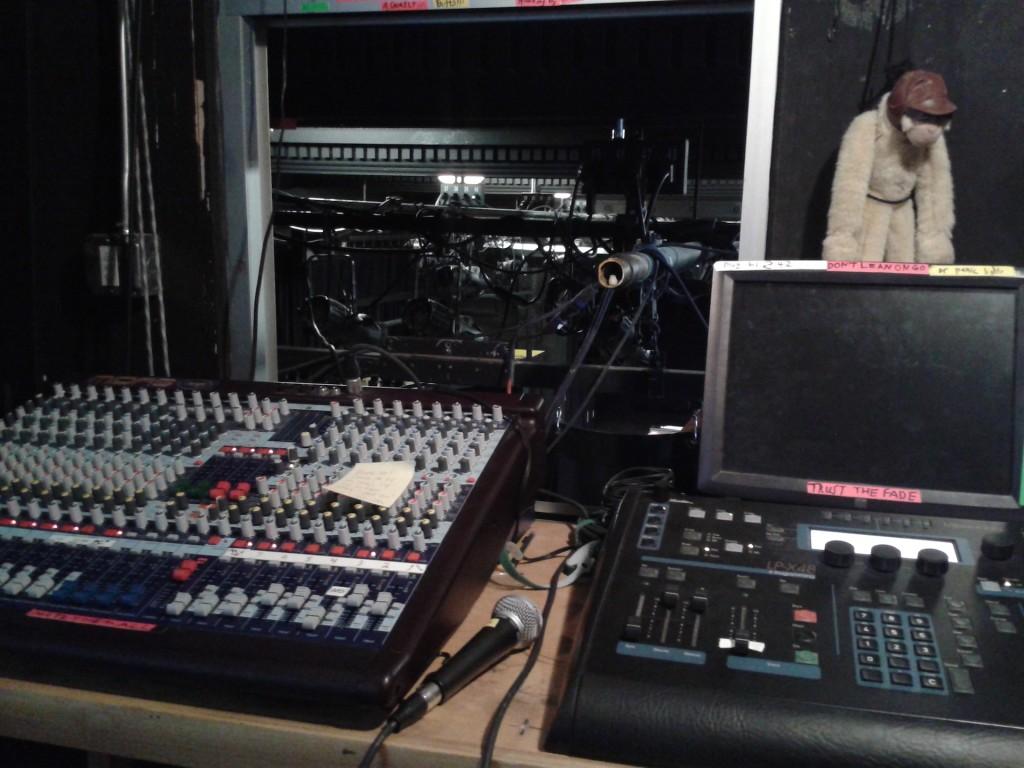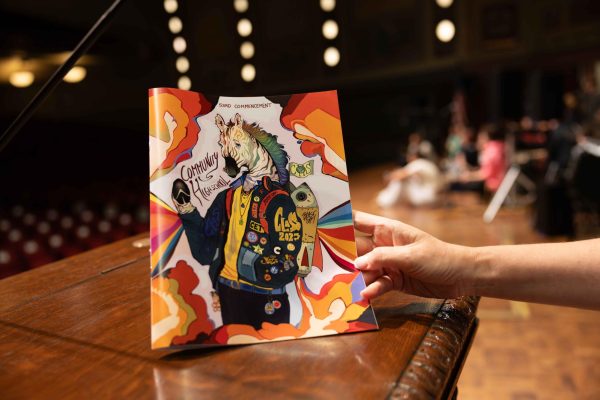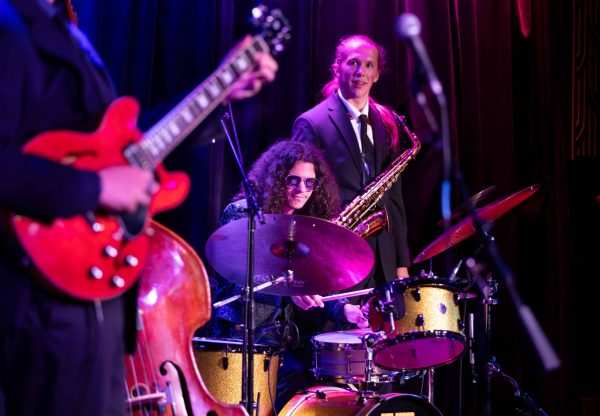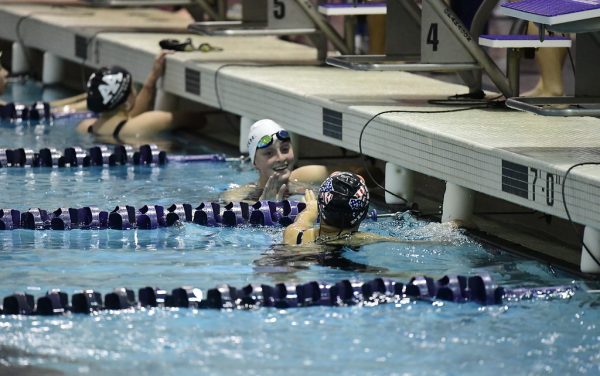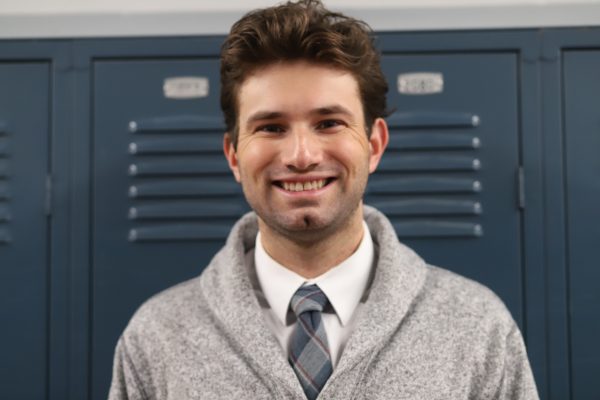Behind the Scenes
As the actors of the Community Ensemble Theater stand on stage and perform during Bob: A Life in Five Acts, Claire Benard and the other running crew members carry a car on stage, set it down, and sneak off. No one notices them. Everyone in the audience is focused on the actors and the story. The tech, working behind the scenes of the show, are rarely noticed by the audience. At the end of the show, when the actors are showered with applause, few people stop to think about the props, sets, lighting and costumes that were used.
Benard, a sophomore at Community, was on sets and running crew for Bob: A Life in Five Acts. This was Benard’s second time on tech. She was interested in theater after watching Avenue Q, also put on by CET, when she was in eighth grade. Afraid of performing on stage, Benard chose to be on tech. “I don’t have a lot of experience acting or any experience at all,” said Benard. “And I felt more comfortable doing tech stuff, just because it’s not performing.”
On sets, Benard was in charge of building the balconies and other larger items used in the show with her fellow sets members. It included cutting wood, drilling holes, screwing pieces together and painting the whole balcony. With so many details, crew members often have a lot to learn when they first enter tech. “In the beginning, you learn how to use tools, all of the different terms and where things are,” said Benard. “Because it has to be safe, with stuff like the balcony. Since this is only my second show, a lot of the stuff I’m learning as I go, and I’m not really experienced in it.”
Tech, which makes up about one third of CET, involves a lot of working in groups. Benard found this difficult. “Even if you don’t like someone, you have to be nice to them or at least work with them, and that can be hard,” said Benard. “You can’t yell at them. You have to work with them.”
Since group work is prominent in tech, choosing crew members take a lot of consideration. Quinn Strassel, the director of CET, tries to look for leadership in crew members. “We choose crew members partly based on experience,” said Strassel. “We have them tell us a little bit about their background with different skills that they have, and different experience they’ve had as leaders.”
The difference in leadership and experience is what makes some people crew heads and others crew members. “If you’re a crew head, the expectation is that you’re going to be a leader,” said Strassel. “You’re going to organize things. If you’re the props crew head you’re going to help with the gathering of all the props, and maybe the design of some the props. If you’re a crew head, you’re a leader.”
Sometimes – even with all the thought in choosing crew members – a couple irresponsible people will be on tech. “There are some people who don’t take (tech) seriously enough or just don’t listen to directions,” said Benard. “And usually that just brings everyone down.”
When careless people are on tech, the other crew members have to accept it. Crew members are usually not replaced due to irresponsibility. “We do really try to be a place where we offer second chances. I think it’s important,” said Strassel. “We don’t expect people to be perfect everyday. Ultimately, if they are just not doing anything, we may have a talk with them, like, ‘Is this something you really want to be doing?’”
The preparations for a show come down to tech week. It is when the final details of the show are perfected. During tech week, CET rehearses the show and fixes anything that doesn’t work. Every member is expected to be working on something. “(Tech week is) basically get up, and go in, and start doing whatever you can,” said Claire Colvin-St. Cyr, a freshmen on lights and sounds for Bob. “And if you don’t have something to do with your own group, you join someone else and start working on whatever that is. Like I was sometimes working on props, the costumes or something, and it’s not really what lights and sounds is, it’s something else. Basically get as much work done as you can and it’s very tiring.”
Because tech week is the only time to make final changes and preparations, it requires everyone in CET to make large time commitments. A normal day in tech week goes from right after school to around 9:00 p.m. This can make turning homework in on time difficult. “I take every free moment I have to get (homework) done,” said Colvin-St. Cyr. “Plus I have a free six block so I get a bunch of it done then.”
From not knowing anything in the beginning to finishing up the final touches in tech week, tech requires time and energy. But because of that, tech brings a great sense of accomplishment. “(Tech is) like doing all these that might be really hard at first,” said Colvin-St. Cyr. “But then at the show, it’s like magic that you created and it’s what you did. No one else did that.”
When the show finally starts, most people are nervous, even the crew members. Mistakes can happen on stage, and no one knows when they will. If mistakes do happen, they have to be dealt with. Most mistakes are not serious. “Sometimes you’ll drop something, or put it in the wrong place,” said Benard. “But usually it gets fixed in time. If you put something in the wrong place, you can just come back out when you’re suppose to be coming out and move it. You’re always suppose to look like you know what you’re doing, even if you don’t.”
Sometimes big mistakes do happen, and in front of an audience, the tech can only depend on the actors to react in a proper way. “In Just Desserts last year, there’s this wall flat, and it started falling down during the scene on the actors, which was not good,” said Benard. “(The actors) handled it really well. The skit was about being in a tree house, so they were like ‘Ah, our tree house is falling down!’ And then some back stage people came and fixed it so it’s not falling over. Then they just got back on with the scene and finish it.”
Only when big mistakes happen do the audience notice the tech. “Let’s say the sound isn’t working on a particular mic, people notice it,” said Strassel. “But a great crew member isn’t noticed. It’s by nature. If nobody notices what you did, then you’re doing an awesome job.”
It’s the crew members who organize every physical item needed to make the show go smoothly, but it’s the actors on stage who get recognition from the audience. “The crew, their job is to make the people on stage look good,” said Strassel. “It’s tough if you’re a crew member, because you don’t always get the same recognition, but people who are real theater people recognize that the crew members are really the ones that do make things happen. They are the ones who make us look good or bad. We would be nothing without the crew.”
Benard doesn’t mind not getting as much recognition by the audience. She thinks she is receiving acknowledgement. “There’s the applause where the actors point up to the booth,” said Benard, “and that’s acknowledging the tech.”



